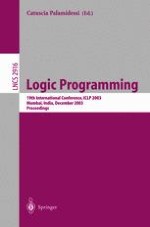2003 | Buch
Logic Programming
19th International Conference, ICLP 2003, Mumbai, India, December 9-13, 2003. Proceedings
herausgegeben von: Catuscia Palamidessi
Verlag: Springer Berlin Heidelberg
Buchreihe : Lecture Notes in Computer Science
Enthalten in: Professional Book Archive
